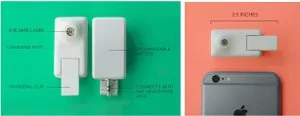Matter and Form Inc. (New York, NY) is currently engaged in a Kickstarter campaign to raise the funds needed to commercialize the “Bevel.” The Bevel is an attachment for smartphones or tablets that will turn the camera in these devices into one that can capture 3D photographs.

A video discussing the Bevel and illustrating the device in operation can be found at the end of this article.
The system utilizes a scanning laser and the camera that is already integrated into most Android or IOS smartphones and tablets. At this time, the only requirement for such a device to be suitable for use with Bevel is that it have an accelerometer and a gyroscope. Kit-Kat or higher or IOS 8 and higher is desired. The company states that “Other phones and tablets are likely to work, and we will do our best to consider them, however, as a starting point, the list above is our development threshold”.
There is no more information on the design or operating principles of the Bevel other than the statement that the laser is eye safe.
Depending on the specific smartphone or tablet, the optimum distance over which the laser can capture 3D is about one meter. In a future release, the company is planning to substantially extend this capability such that the Bevel can capture entire buildings.
Operation of the Bevel does not require that the camera have any minimum resolution. Having said that, the company acknowledges that the quality of the 3D image is better with a higher megapixel camera.
To use the Bevel, it is simply plugged into the smartphone or tablet headphone jack. Then the user pans the person, place or thing.
The Bevel does not use power from the user’s smartphone or tablet. Rather, it is charged with a separate cable. In terms of power consumption, the Bevel can be considered to be a lot like the flash built into most devices. If the laser were to be used constantly, it would provide roughly 3 hours of battery life before needing to be charged. The time to charge the Bevel on a standard adapter is somewhere between 20 and 30 minutes.
Regarding 3D image quality, the company represents that “other 3D attachments create the illusion of 3D by enhancing the depth of an image, but fail to capture a file that you can actually use”. To distinguish the 3D image produced by Bevel from other systems, Matter and Form are calling the process “Genuine 3D photography”. An example of a Bevel Genuine 3D photograph can be viewed online here.
Genuine 3D photographs can be rotated, turned into animated GIFs and viewed from multiple angles. It is also possible to add an image of the background behind the 3D photo.
To operate the system, Bevel users will need to download an app into their smartphone or tablet. The company has also established a web based platform for 3D content management. The site is called Cashew.
Cashew will allow users to share 3D photos on social networks, via text message and by email. Images can be saved for use in, for example, animations and video game designs. Looking a bit into the future, the company indicates that it will be possible to 3D print from photos and scan from 360 degrees.
At the moment, the photos taken with the Bevel can be downloaded directly from Cashew as OBJ, STL, PLY and DAE files.
At the time this article is written, $91,045 has been pledged in the Kickstarter campaign. The goal is to reach $200,000 by August 26. So…assuming that the campaign is successful and that the team is able to deliver on its promises, it is planned that the Bevel will begin shipping in December at a price of $49. – Arthur Berman
Matter and Form, Christina Konecny, 416-533-6767, [email protected]

